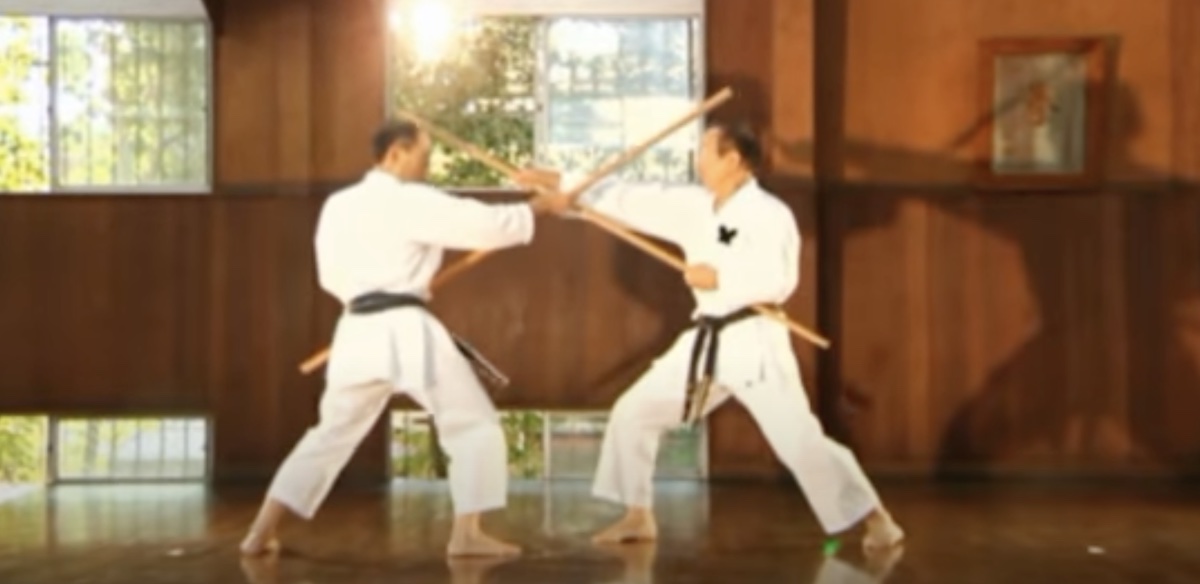Karate Weapons: Everything You Need To Know

Those that know a little bit about the art of Karate may cringe when they hear the term “Karate weapons.” Knowing that martial art is strictly a hand to hand martial art with no weapons included in its teachings.
But if you dig a little deeper, you’ll find that there is some validity to the term Karate weapons. Here is a little history about Karate weapons and how they were developed.
We’ll go over why earlier Okinawans used them and give details of each Karate weapon.
The history of Karate Weapons
While yes, there are no weapons in the modern teachings of Karate. You have to go back to the island of Okinawa 300 years before Karate was developed to find Karate Weapons.
The Ryukyu kingdom that controlled Okinawa since 1429 was overthrown by Japan in 1609. Japan were harsh rulers and implemented strict laws upon the Okinawans.
Most notably, the law that no Okinawans were allowed to own or carry swords. To defend themselves, Okinawans had to be more resourceful.
They resorted to using various farm tools and converting them into weapons. This is where the term “Karate weapons” comes from.
Residents of Okinawa actually became quite proficient at using these early Karate weapons. So much so that some Karate practitioners from centuries later would also practice using them to go along with their Karate.
Okinawa was also where Karate was developed. Before Karate was developed, they used a more primitive style of self defense that Karate would be derived from.
So the term “Karate weapons” does have some merit to it and not just a term made up by mcdojos.
List of Karate weapons
Here is a list of some of the more known Karate weapons complete with a backstory of how they were used.
Tonfa
Tonfas were a common Karate weapon used by poor Okinawan farmers to defend themselves. Originally tonfas were wooden handles on the side of milestones to grind rice.
They were made conveniently removable in case a farmer had to defend themselves against thieves and crooked Japanese soldiers. Typically tonfas were two inches thick and around 17inches long.
Due to their thickness and length they were perfect to guard a user’s forearms against sword and knife attacks. Making them great for defense and counter attacking.
Once the user blocked an attack, they could quickly counter their enemy. Either using the tonfas like a baton to bash their enemy or thrust them with the end of one.
Sais
Sais were another Karate weapon made famous by the Ninja Turtle Raphael. They are synonymous with Japanese culture, but versions of the sai are used throughout Asia.
Most likely coming to Japan from India, where the original version of the sai is called the trisula. In Okinawa, they were used by domestic police for the purpose of crowd control.
They were used as a striking weapon, as well as a blocking weapon. Someone talented with said could easily block a katana strike and deliver a prodding strike to their enemy.
Kamas
Kamas were a very popular Karate weapon that were used by Okinawan wheat farmers. They were originally developed for farmers to cut wheat and grain plants in the fields.
When the sword ban was put into place, kamas were easily adaptable into deadly weapons. One kama was good, but wielding two kamas was even better.
By using two kamas, its users could deliver blitzing slashing attacks from multiple angles. Allso with two kamas, it made it easier for its users to block their enemy’s attacks.
The Bo
The bo or staff is a weapon that is incredibly versatile. Not only considered a Karate weapon, but a weapon used in numerous other martial arts.
Of course, when you don’t have a bladed weapon available to you, the next best thing is a long stock. A bo is one of the best ranged weapons you can use.
You can use it to keep the distance and attack your enemy with thrusts, bashes, and even sweep them. They are also great against sword attacks and allow you to block numerous types of attacks from all directions.
Nunchakus
The nunchucks were made famous by Bruce Lee and were a farming tool used throughout Asia. Its original purpose was to flail rice off of rice plants, but became a Karate weapon during the weapons ban.
To use nunchucks, you need incredible hand and eye coordination. They are incredibly fast and can be used to strike from a distance.
You can also use them to block strikes and possibly lock on joint locks, but be warned.
It is more than likely that you’ll end up hitting yourself with a pair of these.
Jo
The Jo is a Japanese version of the bo staff that was created some time in the early 1600s. It has a couple interesting legends that are similar, but with varying details.
What we know is during the early 1600s, Jo creator Muso Gonnosuke challenged Miyamoto Musashi to a duel. It was a sporting duel and not a duel to the death.
Musashi beats Gonnosuke and it inspires Muso to go to the mountains to train his form. While he was there, he created a shorter version of the staff called the Jo and opened his own school.
Eku
An eku was originally an oar used by Okinawan fisherman. It was actually used well before the weapon ban by fishermen to defend themselves against thieves.
It has the same characteristics of a staff being long-range, but with subtle differences. The eku requires skill to use it since it’s heavier than a staff and the weight is off-balanced.
Many believe that you need to train with the staff before training with the eku.
Tekkos
Tekkos are basically primitive weapons that are very much Karate weapons. They’re basically brass knuckles with blunted points or spikes made from horseshoes.
Since Okinawans were known for practicing martial arts, they knew how to strike. An early martial arts practitioner wearing a pair of tekkos is a deadly combination.
Tambo
The tambo is a miniature version of the staff that was used during the Okinawan weapons ban. Since Okinawans couldn’t have weapons, a stick like the tambo was better than nothing.
A tambo being small and compact made it easy for someone to hide on their person. Whenever they were being confronted, they pulled it out and landed a surprise attack.
Kuwa
A kuwa was basically just a garden hoe used by rural farmers to work their fields. The weapons ban made it an obvious choice to be used as a Karate weapon.
It was long like a bo staff and had a metal blade at the end. Users could attack their enemies from a distance either with thrusts or slashes. Making it a very diverse Karate weapon.
Nunti Bo
The junto bo was originally a spear used by fishermen to strike and kill fish. Being a long spear obviously meant that it was used during the Okinawan weapons ban.
The spear was similar to a trident, but the barbs were angled more down than up. Since the nunti bo had barbs it meant that it did more than just spear an enemy.
Whenever the spear was pulled out, the barbs would rip open the skin and make gruesome wound
Kuruma Bo
A kuruma bo is another classic Karate weapon that was created during the weapons ban. Originally it was used for threshing grain on farms.
It’s a variation of the staff with the end being connected by a chain. With the end being on a chain it allows its user to gain more momentum with swinging strikes.
Tinbe-rochin
A tinbe-rochin was a classic spear and shield combination used by Okinawans. The shield was commonly made of farmer’s conical straw or even a turtle shell.
While straw may seem ineffective it could actually trap an enemy’s weapon within it. The tinbe-rochin was a classic defense and counter weapon. You’d block an enemy’s attack and respond with an attack of your own.
Surujin
A surujin was a modified chain weapon that was a traditional Okinawan weapon. It’s purpose was the same as similar other chain weapons used throughout the world.
They served two specific purposes. You could either wrap the chain around an enemy’s weapon as a defense or strike with the chain.
Putting spikes or metal balls at the end of the surujin were commonly done.
Sansetsukon
This was one of the rare weapons that was not derived from a farming tool. The sansetsukon is a three part staff that is connected together by chains.
It was famously used in China centuries before the weapons ban in Okinawa. Although the Okinawan version is a little bigger.
You can do the same movements with sansetsukon that you can with a staff or nunchuck. When you swing the sansetsukon, the chains whip around creating more velocity on the strike.






